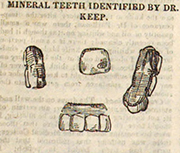
Lollia Paulina
The first known application of forensic odontology occurred during the rule of Roman Empire with the case of Lollia Paulina. In 49 AD, at the request of Julia Agrippina, the wife of Emperor Claudius, Lollia Paulina, Agrippina’s rival, was ordered to commit suicide. As proof that the act had been committed, Agrippina had a Roman soldier bring the head of Lollia Paulina for her to inspect. The story goes that due to the facial features being distorted from the act of suicide and decapitation, Agrippina could not immediately confirm the head did indeed belong to her rival. Then she remembered Lollia Paulina had unique teeth, which Agrippina examined the mouth for, resulting in the confirmation that her rival was indeed no more.
 John Singleton Copley’s Painting of Paul Revere
John Singleton Copley’s Painting of Paul Revere
The first documented application of forensic odontology in the United States was performed by Paul Revere, the famous patriot, who was a skilled metalsmith and self-taught dentist. After the Battle of Bunker Hill, Revere was asked to help identify the remains of the man who sent him on his famous midnight ride, Dr. Joseph Warren. Revere was able to identify Dr. Warren by the artificial tooth he had crafted and placed in Warren’s mouth.
The first court case in the United States to rely on dental work as forensic evidence also happened to be one of the most sensationalized murder trials of the 19th century.

Sketch of mineral teeth of Dr. Parkman identified by Dr. Nathan C. Keep
In the fall of 1849, a respected Boston doctor and philanthropist, Dr. George Parkman, was murdered by Professor John Webster, who owed Dr. Parkman a great deal of money. After being reported missing, and days of searching, Ephraim Littlefield, a janitor for Harvard Medical School whose home shared a wall with Webster’s laboratory, broke into Webster’s laboratory over Thanksgiving break to investigate a “terrible stench.” Mr. Littlefield found Dr. Parkman’s remains, including tooth fragments, which Dr. Parkman’s dentist, Dr. Nathan C. Keep, who would later become the first dean of Harvard’s dental school, was able to positively identify as part of a set of false teeth he had created for Dr. Parkman.
The first recorded criminal conviction in a court case involving a bite mark analysis occurred in Doyle v. The State of Texas, in 1954. The case was a result of a grocery store in the small west Texas city of Aspermontpark was burgled. At the crime scene, investigators found a piece of cheese that had been bitten into by the robber. The day after the burglary, James A. Boyle was arrested for public intoxication. Upon finding thirteen silver dollars in his pocket, the sheriff had Doyle bite into a similar block of cheese. A firearms examiner for the sheriffs’ department took photographs and created plaster of paris impressions from both cheese blocks and concluded that the bite marks were indeed made by the same individual. Dr. Kemp, the local dentist, also testified that he had examined the bite marks and impressions, also coming to the conclusion that they were made by the same individual. The molds were presented at trial, and Doyle was subsequently convicted of the robbery. The defense did not contest the validity of the science, despite not formally being a science at the time, and is considered to be an unprecedented case due to there not being any following by forensic dentists or courts. While the case was used twenty years later to argue the validity of bite mark analysis without question in a court case, this tactic did not exactly work due to the previously mentioned lack of following by experts. Bite mark evidence had been used in cases prior to Doyle, but the suspects were acquitted, leading to this particular case being the first recorded.




